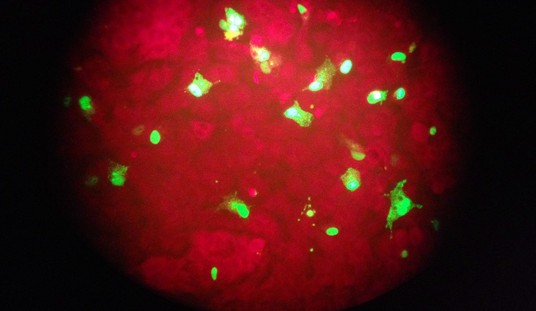Documentarian Phelim McAleer and his wife recently produced the film FrackNation, which presented the largely unreported truth about hydraulic fracturing — that it’s safe, it’s tremendously useful, and the horror stories told by its opponents are mostly fantasy. Phelim stumbled across another largely unreported story about a real horror, and my friend offered to tell it to Hot Air readers today.
Front Row at the Gosnell Horror Show
By Phelim McAleer
So there I was in Philadelphia with a few free days during the recent PA tour of my documentary FrackNation.
What to do with the free time? Friends made suggestions. But from the moment I was invited on the PA tour I knew that as a reporter and news junkie there was only one place to spend my downtime.
It was, of course, the Kermit Gosnell murder trial. I say “of course” because it would be reasonable to assume that most Americans know some of the details of a trial where a doctor is charged with murdering seven children and patients in his clinic.
But in reality most Americans know nothing about the case. When I mentioned on Facebook where I was going the reaction was mostly bewilderment and then horror as they learned the details. Then they were angry that they knew so little about the case. But more on that later.
Philadelphia Criminal Justice Center is very much like all courthouses I’ve covered as a reporter in the past 20 years. The defendants hang around smoking, admiring each others’ tattoos, a few mothers and girlfriends look anxious beside men who are doing their best not to look anxious. And the lawyers walk past, beautifully dressed, talking loudly to their colleagues but in a way that seems designed to impress others several feet away.
And it is busy–very, very busy. People are walking everywhere and milling around. The elevators are so jammed I learned pretty quickly to take the stairs or be trapped in a slow moving box that takes forever.
But make your way up to room 304 and the busyness stops. There’s a single security guard sitting in a chair with a large stack of newspapers. She has plenty of time to chat as you walk through the metal detector.
Inside the courtroom is lopsided. Behind a barrier are the court officials, the jury, the defendant, the lawyers. There is activity as they prepare. Kermit Gosnell seems to be constantly making notes and sharing them with his lawyer. The public side of the courtroom is practically empty and really, really quiet. There are several rows set aside for media. There are just three local reporters. They are outnumbered by a group of pro-life activists.
Then the evidence starts. I used to be a crime reporter and I know that trials have ebbs and flows. And that sometimes you can have the “boring but necessary procedural bits” that are so boring to sit through and impossible to report.
But the Gosnell trial turned this model on its head. Even the boring medical evidence was horrific, and like every reporter when my brain registered “horrific,” I also was thinking “wow, what a great story.” (I think that is why so many journalists get killed in war zones; their brains are different, always thinking about great stories. They don’t see the danger coming until it hits them–sometimes quite literally).
Take for example the evidence of Dr. Fredrick Hellman, the chief medical examiner of Delaware County who became involved when one of Gosnell’s patients gave birth to a dead fetus at a local hospital. Dr. Hellman has a reassuring competent air and his list of qualifications went on and on; you could feel the energy being sucked out of the room as he listed what he had done and where he had worked.
His evidence was similarly lengthy and exhaustive. He was frequently asked to spell the names of drugs and spell out what he meant as his evidence became more and more technical. He described the night in September 2007 when he investigated the remains of Baby Girl Manning who had presented as “a fetal death” at Crozier Chester Hospital.
He talked about charts and measurements and assumptions, and then the District Attorney, in a question that seemed calculated to send the jury to sleep, asked:
“What did you observe externally about this baby of pathological significance?”
Dr. Hellman replied: “I found what appeared to be a pretty well formed baby.”
Suddenly the energy came back into the room. And that is what the case is about. Well formed babies that Dr. Gosnell is alleged to have removed from women by inducing delivery or “precipitating,” as he called it. Then, because they were alive and breathing, he or members of his staff would plunge scissors into the back of the neck and sever the spinal cord. He is charged with doing this seven times, but it is thought he may have done it to hundreds of infants.
The evidence that kept emerging the few days I was there is jaw dropping and poignant. Dr. Hellman explained all the charts that medical professionals have to work out the age of a fetus. They measure the length and width of the baby, they weigh organs, and they compare them to charts of previous autopsies of babies whose age they knew. Dr. Hellman said that based on the charts, he conservatively estimated Baby Girl Manning was between 28- and 29-weeks-old.
He was asked about another incident where a member of staff described an “aborted fetus” as being 18 inches to a foot long. Dr. Hellman was asked to estimate the child’s age given those dimensions. He replied simply that such a baby would be “off the charts.” In other words it was a fully formed baby whose delivery was engineered so that Dr. Gosnell could push a pair of scissors into its neck to snip its spinal cord.
Then we heard from Ashley Baldwin who started to work at the clinic when she was 15.
A murder trial is a funny place for those who attend. It is a closed world, and it is often set in a strange world. In order to really understand what is happening the lawyers, journalists, and jury have to get to know strange people and often stranger places. And like all humans as we get to see more and more about these worlds and people we develop favorites.
And so it seemed to be with the Assistant District Attorney Joanne Pescatore. She obviously has a soft spot for Ms Baldwin. In fact she said as much in her opening remarks.
“Ashley Baldwin is probably my favorite person in this whole case. Ashley Baldwin was 15 when she was working at this facility. Ashley had a work roster from her high school. She was working on the front desk, collecting money, making appointments, that kind of stuff. Smart girl. So smart she could figure things out at 15-years-old. Then something happened and her job morphed into working in the recovery room, doing ultrasounds, drawing blood, giving medication. 15-years-old,” she explained to the jury.
Ms Baldwin was smart, but so were lots of people at the clinic. But what made her a favorite of Ms Pescatore was that despite not being qualified to dispense drugs or assist in the procedures, she seemed to care more than most about the welfare of the patients. In a clinic where, according to investigators, blood and unsterilized equipment was everywhere and murder was a daily occurrence, Ms Baldwin in this perverse universe tried hard to minimize the harm.
She may not have known what exactly was in the drugs she administered but she color coded them to ensure that she and the staff would know what they had given to whom.
In the Women’s Medical Center that was enough to mark you as caring.
Ms Baldwin is now 20 years old. She looks unremarkable and at first sounds unremarkable but then you realise she is a very focussed young woman. You could see her concentrate as she tried to remeber the details of her career at the Women’s medical center. She helped “precipitate” many births–so many she can’t remember the number. Often they were delivered in the toilet. On at least five occasions the babies were moving after being “precipitated.” One was crying. She said it cried just like her own baby “when she first had him.”
She helpfully explained that her son was six pounds when he was born and the baby that was “precipitated” in the toilet was a similar size.
She explained it “looked like a regular baby” and that “there was hair all over it.”
Then there was another baby so big that even Dr. Gosnell joked that it was old enough it could have “walked him home.”
It Is difficult to write about the Kermit Gosnell trial. Almost all the evidence is horrific. As a reporter I want to make this a 5,000 word article but the details are tiring; it is actually hard to believe the moral universe that existed behind the doors of the Women’s Medical Center. And then I remember the hands and feet.
I watch a lot of detective dramas on TV; they tend to focus a lot on serial killers. And often the detectives talk about serial killers taking trophies of their victims. Now I’m sure that not all serial killers take trophies. It makes for a few great gruesome scenes in a TV series, so all TV serial killers seem to collect mementos from their victims. In reality those who take trophies often take scarves, driver’s licenses, or pieces of jewelry.
But it seems that Dr. Kermit Gosnell collected babies’ hands and feet. And he kept them in jars in the kitchen of his clinic. And the jars were transparent. So when you reached up for the coffee as you heated up your panini during lunch, you would have to brush past around 20 jars with the tiny severed hands and feet stored there.
Ms Baldwin would ask Dr. Gosnell about the jars. He told her they were for research, but she never saw any researchers collect them.
I could go on and on and on. And I only spent a few days at the trial. Every minute seemed to throw up new horrors. As a reporter, listening to such evidence was the easy part. Sitting at home now and reflecting on it is more difficult. Who are these people? What kind of world do they live in?
But the case also has a sense of unreality because there has been almost no media coverage of the evidence. There has been almost no analysis or comment regarding a man and his staff who may have taken part in one of the largest mass murders in American history. I find myself questioning my notes because there are almost no other reports verifying what I am now writing. It seems that if a mass murder occurs and no one reports on it it starts to appear as if it never really happened.
This is probably evidence of media bias; journalists who are mostly pro-choice/pro-abortion are reluctant to cover stories that show abortionists in a bad light and would make the case for tighter regulation. There can be no other reason. I say this not to make political points but to simply point out reality.
I have covered the troubles in Northern Ireland and child trafficking in Indonesia and Romania. I have never come across a more sensational case. There is plenty of meat for the tabloid or the “serious” journalist. That they have mostly ignored it is part of the reason their industry is in decline.
I love the traditional media. I spent most of my career working for newspapers or trying to get my documentaries reviewed by them or by establishment TV channels.
But I’m falling out of love with them as they continually let me down. The Kermit Gosnell trial will last another five weeks or so. The media has that time to show they are serious about their profession or if they want to just manage their own decline.
We Wait.
The opinions expressed by the author are his own.








Join the conversation as a VIP Member